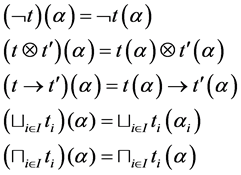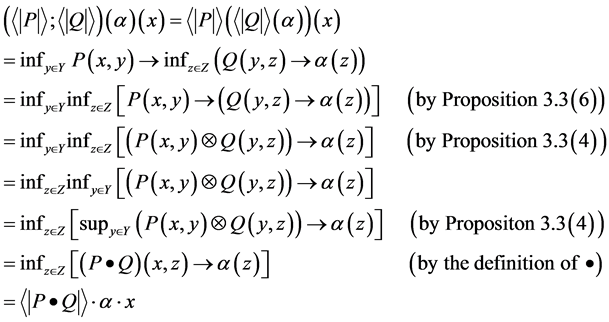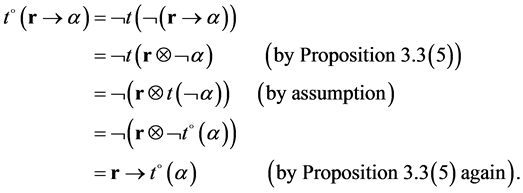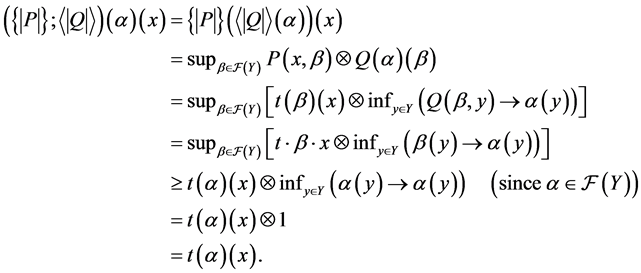Applied Mathematics
Vol.07 No.05(2016), Article ID:64735,18 pages
10.4236/am.2016.75039
Fuzzy Semantics of Contract Language
Hengyang Wu1,2, Yixiang Chen2*
1Information Engineer College, Hangzhou Dianzi University, Hangzhou, China
2MoE Engineering Center for Software/Hardware Co-Design Technology and Application, East China Normal University, Shanghai, China

Copyright © 2016 by authors and Scientific Research Publishing Inc.
This work is licensed under the Creative Commons Attribution International License (CC BY).
http://creativecommons.org/licenses/by/4.0/



Received 5 November 2015; accepted 15 March 2016; published 18 March 2016
ABSTRACT
In this paper, we focus on investigation of the predicate transformer semantics of the contract language introduced by Back and von Wright in their book titled as “Refinement Calculus: A Systematic Introduction” (Springer-Verlag, New York, 1998) in the framework of fuzziness. In order to define fuzzy operations, i.e., fuzzy logic connectives, we take into account implicator ® and its associated T-norm Ä based on residuated lattice theory. Based on these basic fuzzy operations, we introduce the angelic and demonic updates of fuzzy relations. They are the basis of fuzzy predicate transformers in the sense of that any strongly monotone fuzzy predicate transformer can be represented as the sequential composition of the angelic and demonic updates. Together with the standard strong negation , we set up the duality between the angel and demon. The fuzzy predicate transformers semantics of contract statements is established and a simple example of contract statements is given.
, we set up the duality between the angel and demon. The fuzzy predicate transformers semantics of contract statements is established and a simple example of contract statements is given.
Keywords:
Contract Language, Formal Semantics, Residuated Lattice, Fuzzy Predicate Transformers

1. Introduction
There are four main approaches to describe the semantics of some language, i.e., the denotational [1] , the opera- tional [2] , the axiomatic [3] and the algebraic [4] approaches. Predicate transformers semantics [5] [6] is a kind of axiomatic approach to describe semantics of languages. Each statement in a language is characterized by the way it transforms postconditions to preconditions.
Back and von Wright in [7] introduce a contract language ( a detailed introduction in Section 2) describing games that are played between two opponents, called the angel and the demon. The syntax of a contract state- ment S is given by (in BNF-form)

Here P is a relation term and I is a set of higher-order logic which is simply thought of as an index set.
Back and von Wright investigate the transformer semantics of contract language in the Boolean case that the relation P is a classical relation P from X to Y. The angelic update  in an initial state x establishes the
in an initial state x establishes the
postcondition  if there is at least one final state y with
if there is at least one final state y with  satisfying q. The state y satisfying q means
satisfying q. The state y satisfying q means  or
or . Therefore,
. Therefore,
 .
.
Similarly, the demonic update  in an initial state x establishes postcondition q if all final state y with
in an initial state x establishes postcondition q if all final state y with  satisfy q, described by
satisfy q, described by
 .
.
For a given postcondition q, both angelic and demonic updates define preconditions over initial states, describing if initial states satisfy those updates (preconditions), then their outputs of program at these initial states will satisfy the postcondition q. Therefore, both updates define predicate transformers.
Ying in [8] investigates the probabilistic case of Back-Wright contract language. He generalizes the boolean relation to the probabilistic one. Ying sets up the probabilistic semantics of the contract statements based on the probabilistic logic through probabilistic predicate transformers [6] [9] . The probabilistic model for the guarded language is also studied in [10] .
This paper focuses on the establishment of fuzzy semantics of contract language based on fuzzy predicate transformers [11] . Here, the relation P is a fuzzy relation [12] from initial states to final states. For initial state x and final state y, the value , the membership degree of state
, the membership degree of state  belonging to the fuzzy set P, describes indeed the possibility degree of the y to be the output of this program that fuzzy relation P defines from the x. Our goal is twofold: (1) We set up the fuzzy predicate transformer semantics of contract statement S,
belonging to the fuzzy set P, describes indeed the possibility degree of the y to be the output of this program that fuzzy relation P defines from the x. Our goal is twofold: (1) We set up the fuzzy predicate transformer semantics of contract statement S,
which maps a postcondition a over final states, i.e., a fuzzy predicate, into a precondition , a fuzzy predicate over initial states. For a given initial state x, the value
, a fuzzy predicate over initial states. For a given initial state x, the value  is the possibility degree of that
is the possibility degree of that
contract statement S establishes the postcondition a from the x. (2) We study the basis of contract languages such as the duality between angel and demon and the Normal Form Theorem that describes which contract statements are represented as the composition of the angelic and demonic updates.
In our investigation, the residuated lattice theory, which plays an extremely important role in modern fuzzy logic theory, is a foundation [13] . In a residuated lattice


The organization is as follows. In Section 2, we introduce the contract language in detail. We give an example to explain the contract language and explain why we need to deal with contract language in the framework of fuzziness. In Section 3, we recall some basic notions of residuated lattice. In Section 4, we recall the notion of fuzzy relations and introduce ones of fuzzy predicates and fuzzy predicate transformers. A decomposition of fuzzy predicate is given. In Section 5, we introduce two kinds of basic predicate transformers through updates: the angelic and demonic updates. The angelic update is defined via Ä and the demonic update is defined via ®. Moreover, we analysis why it is better to use Wang’s adjoint pair in defining the angelic and demonic update. In Section 6, we set up the fuzzy semantics of contract statements based on the fuzzy predicate transformers. An example is also given in this section. In Section 7, we introduce the duality and give the Duality Theorem which shows the duality between the angel and demon. In Section 8, we consider the monotonicity of fuzzy predicate transformers. We introduce the notion of strongly monotone fuzzy predicate transformers, and prove the Normal Form Theorem which shows that strongly monotone fuzzy predicate transformers can be represented as the sequential composition of the angelic and demonic updates. The followed is the section of conclusion and future work.
2. Contract Language
Back and von Wright introduce a contract language describing games that are played between two opponents, called the angel and the demon, in their book titled as “Refinement Calculus: A Systematic Introduction” (Springer-Verlag, New York, 1998) [7] . The syntax of a contract statement S is given by (in BNF-form)
Here P is a relation term and I a set of higher-order logic which is simply thought of as an index set. We assume that there is a rule that associates a contract statement 


We will interpret contract statements in terms of a game that is played between two opponents, called the angel and the demon. The game semantics describes how a contract statement S encodes the rules of a game. For a play (or execution) of the game (statement S, we also give the initial position (initial statement) 

For a given postcondition q, the angel tries to reach a final state that satisfies q starting from the initial state x. The demon tries to prevent this. Both follow the rules of the game, as described by the statement S. The statement determines the turns of the game, as well as the moves, where each move either leads to a new state or forces the player that is to make the move to quit (and hence lose the game). Each move is carried out by either the angel or the demon.
There are two basic moves, described by the demonic and the angelic update statements. The angelic update statement 


update statement 

The sequential composition 



The demonic 



In the remaining of this section, we will give an example describing contract language and explain why we need to deal with contract language in the framework of fuzziness.
An example in [7] , two opponents are components of a computer system, one could be a client, and the other could be server. The client issues requests to the server, who carries out the requests according to the specification that has been given for the possible requests. The server procedures that are invoked by the client’s requests have conditions associated with them that restrict the input parameters and the global system state. These conditions are assertions for the client, who has to satisfy them when calling a server procedure. The same conditions are assumptions for the server, who may assume that they hold when starting to comply with a request. The server has to achieve some final state (possibly returning some output values) when the assum- ptions are satisfied. This constitutes the contract between the client and the server.
There is an interesting form of duality between the client and the server. When we are programming the client, then any internal choices that the server can make increase our uncertainty about what can happen when a request is invoked. To achieve some desired effect, we have to guard ourselves against any possible choice that the server can make. Thus, the client is the angel and the server is the demon. On the other hand, when we are programming the server, then any choices that the client makes, e.g., in choosing values for the input parameters, increases our uncertainty about the initial state in which the request is made, and all possibilities need to considered when complying with the request. Now, the server is the angel and the client is the demon.
In order to formalize this contract, R.-J. Back and J. von Wright introduce the notion of angelic and demonic update. Let P be a relation from X to Y, 

and
Example. Let 

Assume P is given in Table 1.
Let q is a predicate which means the servers that can be free to download the film “Gone with the wind”. We assume
In the sense of this, we call the set to predicate. It is easy to get 





the film “Gone with the wind” from y by adopting angelic approach. At this time, we call the initial state 

We can see that the underlying logic of this example is two-valued since starting from an initial state, the game reaches a final state or not and final state satisfies given condition (predicate) or not.
However, we can usually say how many possibilities a client connects a server since the tolerated connection time which is caused by the network; how many possibilities the servers can be free to download the film “Gone with the wind” since the properties of servers; thus how many possibilities a client can establish the postcondition(i.e. how many possibilities this client can be free to download this film). That is, it is reasonable to generalize the classical relation into fuzzy relation and the classical predicate into fuzzy predicate. Thus, we generalize the underlying two-valued logic of contract language into fuzzy logic.
3. Residuated Lattice Theory
We note, in the classical two-valued logic, 
Definition 3.1 [14] A residuated lattice on L is an algebra
with four binary operations and two constants such that
Table 1. Relation between clients and servers.
• 



• 



• Ä and ® form an adjoint pair, i.e.
Given a residuated lattice


In what follows, Ä is sometimes called generalized triangular norm (some literature also call it product) and ® is called the residuum of Ä. We denote 






Definition 3.2 [15] Let 




Example. Taking

• Łukasiewicz’s adjoint pair:
• Gödel’s adjoint pair:
• Goguen’s adjoint pair:
• Wang’s adjoint pair:
For the above four situations, one can verify that 


Remark. Ying in [8] investigates the probabilistic game semantics of contracts in Section 8. He uses the probabilistic logic based on Goguen implicator and the corresponding adjoint. Hence, Ying can not get the duality theorem in Section 8( Theorem 8.4).
The following properties are useful for our discussion. Their proofs are straightforward and can be found in, e.g., [16] [17] .
Proposition 3.3 Let 

(1) 
(2)
(3)
(4) 
(5)
(6)
(7) 

(8)
(9)
Note that, in this paper, we use a regular residuated lattice with the hybrid monotonic implicator.
4. Fuzzy Relation and Predicate Transformers
This section will recall three basic notions of fuzzy predicates, fuzzy relations and fuzzy predicate transformers, on which we define some operations.
4.1. Fuzzy Predicates
This paper focuses on the establishment of fuzzy semantics of contract statements based on the fuzzy predicate transformers. Now we will recall these notions of fuzzy predicate and fuzzy predicate transformers.
Definition 4.1 A fuzzy predicate on a state space X is any mapping from X to the unit interval [0,1]. We denote the set of fuzzy predicates on X by




Remark. Indeed, fuzzy predicate on X in this paper is in fact fuzzy set on X, we call it fuzzy predicate in order to coincide with the notion in the computer science. On the other hand, usually the notion fuzzy predicate is different from that of fuzzy set. For example, in [11] [18] fuzzy predicate over a dcpo X, a directed complete poset, is Scott continuous function from this dcpo to the unit interval 






The join 


The fuzzy predicate space 



For any








In addition to the greatest lower bound and the least upper bound, we introduce the logical connectives: negation

For all 
In particular, 
It is easily verified that 
Proposition 4.2 (Decomposition of fuzzy predicates) For any
and
where 
Proof. We have 

Since

4.2. Fuzzy Predicates Transformers
The notion of fuzzy predicate transformers comes from [18] , the authors use it to set up the logical semantics of possibility computation.
Definition 4.3 (1) A fuzzy predicate transformer (FPT, for short) from the state space X to Y is any mapping from 


(2) The refinement order 



(3) A fuzzy predicate transformer 



For any





All operations on fuzzy predicates may be pointwise extended to fuzzy predicate transformers:
in particular,
for all

Moreover, we define the sequential composition of fuzzy predicate transformers. For 





4.3. Fuzzy Relations
Relations appear in many fields of mathematics and computer science. In classical mathematics these relations are usually crisp, i.e., two objects are related or they are not. However, many relations in real-word applications are intrinsically fuzzy, i.e., objects can be related to each other to a certain degree [19] .
Definition 4.4 For given two state spaces X and Y, a fuzzy relation P from X to Y is a fuzzy set on the product




The join 



For the algebraic structure of

for 




Definition 4.5 [12] [20] For fuzzy relations 



for all 

Some basic properties of composition are collected in the next proposition. We omit the straightforward proofs.
Proposition 4.6 Let 

(1)
(2)
(3)
(4)
Remark 2. 

Let 





However,
This shows that 
Further, the following proposition is easily gotten.
Proposition 4.7 Let



5. Basic Predicate Transformers
This section will introduce two basic fuzzy predicate transformers through an update method applied to fuzzy relations and analysis them through adjoint pairs.
5.1. Angelic and Demonic Update
As documented in [7] , for a given Boolean relation P from X to Y and a Boolean predicate


Ying in [8] defines the notions of angelic and demonic updates in the probabilistic case by translating the two logical formulae above into probabilistic logic (see Definition 6, page 334).
Here, we define these updates in the possibility case. Since the existential and universal quantifiers can be interpreted by supremum and infimum, respectively, one arrives at the following definition.
Definition 5.1 Let X and Y be two state spaces and




where 
Both angelic and demonic updates define fuzzy predicate transformers from state space X to state space Y. That is, for any fuzzy predicate (postcondition)




with the degree 



Remark. The angelic and demonic updates are similar to the definition of upper and lower fuzzy rough approximation in [19] , but a little difference.
where A is a fuzzy set in X. We can see that if P is fuzzy relation in








In next section, we will establish the fuzzy predicate transformer semantics of contract statements. Here, we discuss some properties of these basic updates.
Proposition 5.2
Proposition 5.3 Let



Proof. We only prove 





In particular, we take



This proposition tells us that the order is preserved by the angelic update and reversed by the demonic update.
The following two propositions present homomorphic properties of the angelic and demonic update operators on fuzzy relations.
Proposition 5.4 Let 


(1)
(2)
Proof. We only prove (2), the proof of (1) being similar. For 

□
The above proposition shows that the updates and the composition of fuzzy relations commute, whereas the next proposition indicates that the angelic update preserves unions of fuzzy relations, and the demonic update changes a union of fuzzy relations into a meet.
Proposition 5.5 Let 

(1)
(2)
Proof. The straightforward proofs use Definition 5.1 and properties of Ä and ®. □
5.2. Analysis
In this subsection, we will analysis angelic and demonic update through different adjoint pairs. We wish to choose more appropriate those to apply contract language.
Usually, in some game, we always assume “I” am angel and opponent is demon. I always wants to win and prevents opponent to win. For fuzzy situation, I always tries to maximize the possibility of wining and minimize possibility of winning of the opponent. Since, in this paper, we discuss contract language only under regular residuated lattice, we compare Łukasiewicz’s adjoint pair with Wang’s adjoint pair for the sake of familiarity.
For a given postcondition 



and
respectively.
It is easy to verify that for any




On the other hand, the demonic update 

and
respectively.
Clearly, for any




Hence, considering the previous two factors, it seems more appropriate to use Wang’s adjoint pair in contract language.
6. Fuzzy Semantics of Contract Language
Based on the previous discussion, we propose the fuzzy predicate transformer semantics of the contract language. The syntax of contract statements is given by
Here P is a fuzzy relation term and I a set of higher-order logic which is simply thought of as an index set.
Definition 6.1 The fuzzy predicate transformer semantics 
We are supposed to give a contract statement S which is described by a fuzzy relation P from state space X to state space Y. These semantics of the angelic update 



Now, we continue the example in section three. Fuzzy relations from X to Y are given in Table 2.
Table 2. The fuzzy relation between clients and servers.
A postcondition a means the possibilities that the servers can be free to download the film “Gone with the wind”, which can be given as a fuzzy predicate as follows.


If we take ® and Ä in the demonic and angelic update to Wang implicator and its adjoint, then through computing, we can get
and
and
We can see 


Suppose the contract statement
If we have the contract statement
From these two formulae above, we can get that the contract statement S1 will establish the postcondition a (i.e. downloads the film “Gone with the wind”) from the initial state 
7. The Duality
The angelic and demonic updates are basic strategies of contract language. The angel always wants to win, however, the demon always tries to prevent this winning. Of course, the angel also prevents the demon to win. Therefore, the angel and demon are a pair of opponents which present a duality between them.
In this section we introduce a duality for fuzzy predicate transformers through negation to confirm this duality. The specification language of Back and von Wright [21] was based on the fundamental dualities between demonic and angelic nondeterminism and between nontermination and miracles. Dijkstra and Scholten [5] introduced a notion of converse predicates that is closely related to duals.
Definition 7.1 The dual 



As




Definition 7.2 Let
(1) t has the scaling property, if 


(2) t has the implication property, if 


The following proposition shows that the scaling property and the implication property are dual in the sense that an FPT t has the scaling property if and only if 
Proposition 7.3 Let t be an FPT from X to Y. Then, t has the scaling property if and only if its dual 

Proof. Assume that t has the scaling property, i.e., 


So, the dual 
Conversely, let t have the implication property. Then
Therefore, 
Theorem 7.4 (Duality Theorem) The following dualities hold for fuzzy predicate transformers:
Proof. We only prove 




Hence
Now, let



Proposition 7.5 Let


Proof. Due to the duality, we only need to prove that 



8. Monotonicity
In the previous section, we set up the fuzzy predicate transformer semantics of contract statements. It is well- known that not all predicate transformers are interpretations of programming statements. Dijkstra [22] stated that predicate transformers accepted as semantic functions of programming statements are required to satisfy certain healthiness conditions. The basic conditions, that he imposed originally, were strictness, monotonicity, conjunc- tivity and disjunctivity. With respect to possibility computations, we proposed healthiness conditions in [18] (Definition 3.4, p. 2666).
R. J. Back and J. von Wright in [7] discovered a very interesting theorem, called the Normal Form Theorem, which says that all monotone predicate transformers can be represented in terms of angelic and demonic updates. In this section, we will introduce the notion of strong monotonicity and establish the Normal Form Theorem for fuzzy predicate transformers. which answers what fuzzy predicate transformers can be represented by angelic and demonic updates of fuzzy relations (see, Theorem 8.6 below).
Definition 8.1 [23] Let X be a state space. For two fuzzy predicates a and b in X, the degree of I-inclusion of a in b is given by
Note that this notion is also called strength of implication by Ying in [8] .
For instance, let X be the set of non-negative integers and let









Definition 8.2 Let X and Y be two state spaces, and


It is easy to see that strong monotonicity implies (weak) monotonicity, but the converse does not hold.
Proposition 8.3 If FPT t is strongly monotone then so is
Proof. Assume that t is a strongly monotone FPT from X to Y. We need to show that the dual FPT 


Therefore, 
We will show that strong monotonicity can be derived from (weak) monotonicity and the scaling property.
Proposition 8.4 Assume that an FPT 
Proof. We have to show:



We now establish the normal form theorem for fuzzy predicate transformers. We first give a theorem which says that updates of all basic statements are strongly monotone and that operations for constructing compound statements also preserve strong monotonicity.
Theorem 8.5 Strong monotonicity is closed under composition, meet, and join of fuzzy predicate transformers.
Proof. (1) We prove that meet of fuzzy predicate transformers preserves strong monotonicity. Let 

Hence, meets preserve strong monotonicity. Similarly, we can prove that joins of fuzzy predicate transformers preserve strong monotonicity.
(2) We prove that composition preserves strong monotonicity. Let


Hence, composition preserves strong monotonicity. □
Now we present the Normal Form Theorem for strongly monotone fuzzy predicate transformers.
Theorem 8.6 (Normal Form Theorem) Let X and Y be two state spaces and

Proof. The “if” part. By Proposition 7.5, 





The “only if” part. We define fuzzy relations 

for all 

On the other hand, for any
Therefore,
We have gotten that

9. Conclusion and Further Work
We have given the fuzzy predicate transformer semantics of contract langauge introduced by Back and von Wright in [7] . Adjoint pair of a residuated lattice is used to define the fuzzy logic connectives: implication and production. In terms of these fuzzy operations, we have defined the fuzzy updates of the angelic and demonic statements in contract language. These two updates are the basis of fuzzy predicate transformers in the sense that strongly monotone fuzzy predicate transformers are just the sequential composition of these angelic and demonic updates of two fuzzy relations, which is called as Normal Form Theorem. Together with the standard strong negation, we have set up the duality of fuzzy predicate transformers. The duality describes the duality between the angel and the demon, which says that the angel and demon in games can change their strategies each other. In the future, we need to consider the denotational [1] and operational semantics [2] in the frame- work of fuzziness. Moreover, those semantics of contract language should be considered by taking into count the conditional structure if b then S1 else S2 and loop structure while b do S.
Recently, Wang and Zhou [24] establish the foundation of quantitative logic. Pei [25] investigates the full implication of fuzzy reasoning. Both will promote the research on the quantitative semantics with respect to fuzzy programming language.
Acknowledgements
The first author was supported by the Zhejiang Provincial Natural Science Foundation of China (LY13F020046) and Zhejiang Provincial Education Department Fund of China (Y201223001). The second author acknowledges support from the Natural Science Foundation of China (No. 61370100) and the Shanghai Leading Academic Discipline Project (B412).
Cite this paper
HengyangWu,YixiangChen, (2016) Fuzzy Semantics of Contract Language. Applied Mathematics,07,422-439. doi: 10.4236/am.2016.75039
References
- 1. Stoy, J.E. (1977) Denotational Semantics: The Scott-Strachey Approach to Programming Language Theory. MIT Press, Cambridge, MA.
- 2. Plotkin, G.D. (1981) An Structural Approach to Operational Semantics. Technical Report DAIMI FN-19, Computer Science Department, Aarhus University.
- 3. Hoare, C.A.R. (1969) An Axiomatic Basis for Computer Programming. Communications of the ACM, 12, 576-580.
http://dx.doi.org/10.1145/363235.363259 - 4. Van Horebeek, I. and Lewi, J. (1989) Algebraic Specifications in Software Engineering an Introduction. Springer-Verlag, Berlin Heidelberg, New York.
- 5. Dijkstra, E.W. and Scholten, C.S. (1990) Predicate Calculus and Programs Semantics. Springer-Verlag, New York.
- 6. Hoare, C.A.R. (1978) Some Properties of Predicate Transformers. Journal of the Association for Computing Machinery, 25, 461-480.
http://dx.doi.org/10.1145/322077.322088 - 7. Back, R.-J. and von Wright, J. (1998) Refinement Calculus: A Systematic Introduction. Springer-Verlag, New York.
http://dx.doi.org/10.1007/978-1-4612-1674-2 - 8. Ying, M.S. (2003) Reasoning about Probabilistic Sequential Programs in a Probabilistic Logic. Acta Informatica, 39, 315-389.
http://dx.doi.org/10.1007/s00236-003-0113-z - 9. Morgan, C., McIver, A.K. and Seidel, K. (1996) Probabilistic Predicate Transformers. ACM Transactions on Programming Languages and Systems, 18, 325-353.
http://dx.doi.org/10.1145/229542.229547 - 10. He, J., Seidel, K. and McIver, A.K. (1997) Probabilistic Models for the Guarded Command Language. Science of Computer Programming, 28, 171-192.
http://dx.doi.org/10.1016/S0167-6423(96)00019-6 - 11. Chen, Y.X. and Jung, A. (2004) An Introduction to Fuzzy Predicate Transformers. The Third International Symposium on Domain Theory, Xi’an, 10-24 May 2004.
- 12. Zadeh, L.A. (1965) Fuzzy Sets. Information and Control, 8, 338-353.
http://dx.doi.org/10.1016/S0019-9958(65)90241-X - 13. Dilworth, R.P. and Ward, N. (1939) Residuated Lattices. Transactions of the American Mathematical Society, 45, 335-354.
http://dx.doi.org/10.1090/S0002-9947-1939-1501995-3 - 14. Daňková, M. (2010) Approximation of Extensional Fuzzy Relations over a Residuated Lattice. Fuzzy Sets and Systems, 161, 1973-1991.
http://dx.doi.org/10.1016/j.fss.2010.03.011 - 15. She, Y.H. and Wang, G.J. (2009) An Axiomatic Approach of Fuzzy Rough Sets Based on Residuated Lattices. Computers and Mathematics with Applications, 58, 189-201.
http://dx.doi.org/10.1016/j.camwa.2009.03.100 - 16. Wang, G.J. (1999) On the Logic Foundation of Fuzzy Reasoning. Information Sciences, 117, 47-88.
http://dx.doi.org/10.1016/S0020-0255(98)10103-2 - 17. Wang, G.J. and Wang, H. (2001) Non-Fuzzy Versions of Fuzzy Reasoning in Classical Logics. Information Sciences, 138, 211-236.
http://dx.doi.org/10.1016/S0020-0255(01)00131-1 - 18. Chen, Y.X. and Wu, H.Y. (2008) Domain Semantics of Possibility Computations. Information Sciences, 178, 2661-2679.
http://dx.doi.org/10.1016/j.ins.2008.01.016 - 19. Nachtegael, M., De Cock, M., Van der Weken, D. and Kerre, E.E. (2002) Fuzzy Relational Images in Computer Science. In: de Swart, H., Ed., Lecture Notes in Computer Science, Vol. 2561, Springer, Berlin, 134-151.
http://dx.doi.org/10.1007/3-540-36280-0_10 - 20. Bandler, W. and Kohout, L.J. (1980) Fuzzy Relational Products as a tool for Analysis and Synthesis of the Behaviour of Complex Natural and Artificial Systems. In: Wang, S.K. and Chang, P.P., Eds., Fuzzy Sets: Theory and Application to Policy Analysis and Information Systems, Plenum Press, New York and London, 341-367.
http://dx.doi.org/10.1007/978-1-4684-3848-2_26 - 21. Back, R.-J. and von Wright, J. (1990) Duality in Specification Languages: A Lattice-Theoretical Approach. Acta Informatica, 27, 583-625.
http://dx.doi.org/10.1007/BF00259469 - 22. Dijkstra, E.W. (1976) A Discipline of Programming. Prentice Hall, Inc., Englewood Cliffs, 1976.
- 23. Bandler, W. and Kohout, L.J. (1980) Fuzzy Power Sets and Fuzzy Implication Operators. Fuzzy Sets and Systems, 4, 13-30.
http://dx.doi.org/10.1016/0165-0114(80)90060-3 - 24. Wang, G.J. and Zhou, H.J. (2009) Quantitative Logic. Information Sciences, 179, 226-247.
http://dx.doi.org/10.1016/j.ins.2008.09.008 - 25. Pei, D.W. (2008) Unified Full Implication Algorithms of Fuzzy Reasoning. Information Sciences, 178, 520-530.
http://dx.doi.org/10.1016/j.ins.2007.09.003
NOTES
*Corresponding author.

































































